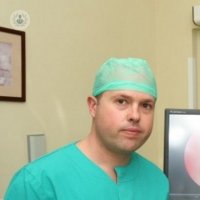How you can treat prostatic hyperplasia?
Written by:The prostate is an exclusive male organ that deals with the secretion of much of the seminal fluid to transport and nourish sperm and increase the chances of survival and success of fertilization.
As the years pass, the body grows in all men, and this phenomenon is called hyperplasia. Thus, benign prostatic hyperplasia (BPH) is not more than the noncancerous growth of the gland.

Symptoms of prostatic hyperplasia
The main consequence of prostatic hyperplasia is blockage of urine output. In the first phase, the patient usually has few symptoms, because the bladder is still able to compensate for this obstruction.
However, as the urethra narrows by compression of the prostate, the patient has a set of symptoms called prostatism or symptoms of lower urinary tract symptoms (LUTS): difficulty and delay in the onset of micturition, sensation of incomplete emptying , decreased strength of the urine stream, intermittent or prolonged urination, dribbling after urination, urinary retention, incontinence, among others.
In a more advanced stage, the patient is more worrisome symptoms decreased functional bladder capacity, urinary frequency (more micturition but little quantity), nocturia (involuntary urination at night) and incontinence urgently. These symptoms are due to involuntary contractions of the bladder.
Treatment of prostatic hyperplasia
Currently, there are two basic to treat benign prostatic hyperplasia options: medical treatment and surgery. It is recommended to consider the patient's symptoms, age, stage in which hyperplasia, concomitant diseases is found, among others, to choose the method to treat it.
Thus, in the case of surgery, it is performed when medical treatment has not eased enough symptoms when the patient can not take their duties normally, or does not want to take medication.
Within the surgical treatment of prostatic hyperplasia, there are two techniques:
- Intervention endoscopically: is via the urethra (transurethral). It is advisable for patients with heart problems.
- open prostate surgery: recommended for large prostates, as it allows for better extraction.
Both traditional methods involve a significant risk of complications and require hospitalization of between 3 and 10 days.
Laser surgery to treat benign prostatic hyperplasia
Laser surgery is a new surgical technique for prostate surgery transurethral so without making an incision in the abdomen. This surgical method is by far the best treatment of benign prostatic hyperplasia prostate, as it is minimally invasive, does not cause bleeding and is as safe and effective as the other surgeries.
Currently, in specialized centers in Urology there are several types of lasers to treat benign prostatic hyperplasia:
- Blue lasers or laser holmium completely removes the prostate tissue without causing bleeding (vaporization) and allow to extract tissue samples for analysis (enucleation), but has less power (100W), so the intervention time is longer.
- Green laser or KTP: allows vaporization of prostate without enucleation, with 120W and 180W power, high-power fiber cooled by saline.
- red or laser diodes: allows vaporization and enucleation. 180W has a power uncooled fiber.
Operation of laser technology
This technology uses a next-generation laser and high energy that binds with an optical fiber and vaporizes the soft tissues of the prostate, completely removing the enlarged prostate tissue.
Laser surgery involves inserting a cystoscope (thin tube) double current laser fiber through the urethra to vaporize the prostate. Moreover, as already mentioned above, the laser seals blood vessels, so prevents bleeding and allows the patient leaves the center with a probe that can be removed within one or two days. Thus, this method is fully effective, safe and comfortable for the patient.
Advantages of Laser Surgery
Laser technology to treat benign prostatic hyperplasia has several advantages over other types of treatment:
- Minimally invasive
- lasting results
- No complications or typical risks of other treatments
- Outpatient or hospital admission minimum
- No blood loss (recommended for high-risk patients on anticoagulation therapy)
- rapid relief of symptoms • Rapid recovery of daily patient activity
- bladder catheterization generally less than 24-48 hours
- Minimal risk of incontinence and impotence
Postoperative laser surgery
While with traditional surgical procedures such as open surgery, the patient was bleeding when urinating and recovery lasted a week, the laser does not cause any wound that can bleed, provides immediate relief of symptoms and recovery is very quick and painless.
Thus, postoperative laser surgery is faster and more bearable than other treatments. Hospital admission is between 24 and 48 hours and 10 days most patients no longer have discomfort and claim that they do have are minimal and not affected their daily activity.




